Network-Based Space-Time Scan Statistics for Detecting Micro-Scale Hotspots
Abstract
:1. Introduction
2. Related Work
3. Methodology
3.1. Building Scan Statistics for Searching in a Network Space
3.2. Assumptions
3.3. Null and Alternative Hypotheses
3.4. Likelihood Ratio Function
3.5. The Most Likely and Secondary Clusters
4. Analysis with Synthetic Data
4.1. The Space-Time Poisson Cluster Process
4.2. Comparison of PLScan and NetScan
4.3. Performance Assessment
5. Empirical Analysis
5.1. Empirical Data
5.2. Application of NetScan to Drug Incidents in Chicago
6. Discussion
7. Conclusions
Author Contributions
Funding
Institutional Review Board Statement
Informed Consent Statement
Data Availability Statement
Conflicts of Interest
References
- Chorley, R.J.; Haggett, P. (Eds.) Models in Geography; Methuen: London, UK, 1967. [Google Scholar]
- Clark, P.J.; Evans, F.C. Distance to nearest neighbor as a measure of spatial relationships in populations. Ecology 1954, 35, 445–453. [Google Scholar] [CrossRef]
- Diggle, P.J.; Besag, J.; Gleaves, J.T. Statistical analysis of spatial point patterns by means of distance methods. Biometrics 1976, 32, 659–667. [Google Scholar] [CrossRef]
- Ripley, B.D. The second-order analysis of stationary point process. J. Appl. Probab. 1976, 13, 255–266. [Google Scholar] [CrossRef] [Green Version]
- Ripley, B.D. Spatial Statistics; John Wiley & Sons: New York, NY, USA, 1981. [Google Scholar]
- Boots, B.N.; Getis, A. Point Pattern Analysis; Sage Publications: Thousand Oaks, CA, USA, 1988. [Google Scholar]
- Knox, E.G. Detection of clusters. In Methodology of Enquiries into Disease Clustering; Elliott, P., Ed.; Small Area Health Statistics Unit: London, UK, 1989; pp. 17–20. [Google Scholar]
- Kulldorff, M.; Nagarwalla, N. Spatial disease clusters: Detection and inference. Stat. Med. 1995, 14, 799–810. [Google Scholar] [CrossRef]
- Rogerson, P.A. Monitoring point patterns for the development of spacetime clusters. J. R. Stat. Soc. Ser. A Stat. Soc. 2001, 164, 87–96. [Google Scholar] [CrossRef]
- Weisburd, D.; Bushway, S.; Lum, C.; Yang, S.-M. Trajectories of crime at places: A longitudinal study of street segments in the city of Seattle. Criminology 2004, 42, 283–321. [Google Scholar] [CrossRef]
- Braga, A.A.; Papachristos, A.V.; Hureau, D.M. The concentration and stability of gun violence at micro places in Boston, 1980–2008. J. Quant. Criminol. 2010, 26, 33–53. [Google Scholar] [CrossRef]
- Weisburd, D.; Telep, C.W. Hot spots policing: What we know and what we need to know. J. Contemp. Crim. 2014, 30, 200–220. [Google Scholar] [CrossRef]
- Lee, Y.; Eck, J.E.; Martinez, N.N. How concentrated is crime at places? A systematic review from 1970 to 2015. Crime Sci. 2017, 6, 6. [Google Scholar] [CrossRef]
- Oliveira, M.; Bastos-Filho, C.; Menezes, R. The scaling of crime concentration in cities. PLoS ONE 2017, 12, e0183110. [Google Scholar] [CrossRef]
- Mohler, G.; Porter, M.; Carter, J.; LaFree, G. Learning to rank spatio-temporal event hotspots. Crime Sci. 2020, 9, 3. [Google Scholar] [CrossRef] [Green Version]
- Weisburd, D. The law of crime concentration and the criminology of place. Criminology 2015, 53, 133–157. [Google Scholar] [CrossRef]
- O’Brien, D.; Winship, C. The Gains of Greater Granularity: The Presence and Persistence of Problem Properties in Urban Neighborhoods. J. Quant. Criminol. 2017, 33, 649–674. [Google Scholar] [CrossRef]
- Robinson, A.H. Early Thematic Mapping in the History of Cartography; University of Chicago Press: Chicago, IL, USA, 1982. [Google Scholar]
- Evans, D.J.; Herbert, D.T. The Geography of Crime; Routledge: London, UK, 1989. [Google Scholar]
- Weisburd, D.; McEwen, T. Crime Mapping and Crime Prevention; Criminal Justice Press: New York, NY, USA, 1998. [Google Scholar]
- Braga, A.A.; Weisburd, D.L. Editors’ introduction: Empirical evidence on the relevance of place in criminology. J. Quant. Criminol. 2010, 26, 1–6. [Google Scholar] [CrossRef] [Green Version]
- Braga, A.A.; Papachristos, A.V.; Hureau, D.M. The effects of hot spots policing on crime: An updated systematic review and meta-analysis. Justice Q. 2014, 31, 633–663. [Google Scholar] [CrossRef]
- Weisburd, D.; Groff, E.R.; Yang, S. The Criminology of Place: Street Segments and Our Understanding of The Crime Problem; Oxford University Press: New York, NY, USA, 2012. [Google Scholar]
- Braga, A.A. The effects of hot spots policing on crime. Ann. Am. Acad. Pol. Soc. Sci. 2001, 455, 104–125. [Google Scholar] [CrossRef]
- Weisburd, D.; Eck, J. What can police do to reduce crime, disorder and fear? Ann. Am. Acad. Pol. Soc. Sci. 2004, 593, 42–65. [Google Scholar] [CrossRef]
- Weisburd, D.; Braga, A. Hot spots policing as a model for police innovation. In Police Innovation: Contrasting Perspectives; Weisburd, D., Braga, A., Eds.; Cambridge University Press: Cambridge, UK, 2006; pp. 225–244. [Google Scholar]
- Weisburd, D.; Morris, N.A.; Groff, E.R. Hot spots of juvenile crime: A longitudinal study of arrest incidents at street segments in Seattle, Washington. J. Quant. Criminol. 2009, 25, 443–467. [Google Scholar] [CrossRef]
- Dau, P.M.; Dewinter, M.; Witlox, F.; Vander Beken, T.; Vandeviver, C. How concentrated are police on crime? A spatiotemporal analysis of the concentration of police presence and crime. Camb. J. Evid.-Based Polic. 2022. [Google Scholar] [CrossRef]
- Braga, A.A.; Turchan, B.S.; Papachristos, A.V.; Hureau, D.M. Hot spots policing and crime reduction: An update of an ongoing systematic review and meta-analysis. J. Exp. Criminol. 2019, 15, 289–311. [Google Scholar] [CrossRef]
- Braga, A.A.; Hureau, D.; Winship, C. Losing faith? Police, black churches, and the resurgence of youth violence in Boston. Ohio State J. Crim. Law 2008, 6, 141–172. [Google Scholar]
- Weisburd, D.; Zastrow, T. Crime Hot Spots: A Study of New York City Streets in 2010, 2015, and 2020, Report to Manhattan Institute 2021. Available online: https://www.manhattan-institute.org/weisburd-zastrow-crime-hot-spots (accessed on 1 November 2022).
- Eck, J. Review essay: Examining routine activity theory. Justice Q. 1995, 12, 783–797. [Google Scholar] [CrossRef]
- Eck, J.E.; Weisburd, D. Crime places in crime theory. In Crime and Place; Eck., J., Weisburd, D., Eds.; Crime Justice Press: Monsey, NY, USA, 1995; pp. 1–33. [Google Scholar]
- Sherman, L.W. Hot spots of crime and criminal careers of places. In Crime and Place. Crime Prevention Studies; Eck, J., Weisburd, D., Eds.; Willow Tree Press: Monsley, NY, USA, 1995; Volume 4, pp. 35–52. [Google Scholar]
- Taylor, R. Social order and disorder of street-blocks and neighborhoods: Ecology, micro-ecology, and the systematic model of social disorganization. J. Res. Crime Delinq. 1997, 34, 113–155. [Google Scholar] [CrossRef]
- Taylor, R. Crime in Small-Scale Places: What We Know, What We Can Prevent and What Else We Need to Know. In Crime and Place: Plenary Papers of the 1997 Conference on Criminal Justice Research and Evaluation; Travis, J., Ed.; U.S. National Institute of Justice: Washington, DC, USA, 1998. [Google Scholar]
- Van Wilsem, J. Urban streets as micro contexts to commit violence. In Putting Crime in Its Place: Units of Analysis in Geographic Criminology; Weisburd, D., Bernasco, W., Bruinsma, G.J.N., Eds.; Springer Verlag: New York, NY, USA, 2009. [Google Scholar]
- Di Bella, E.; Corsi, M.; Leporatti, L.; Persico, L. The spatial configuration of urban crime environments and statistical modeling. Environ. Plan. B Plann. Des. 2017, 44, 647–667. [Google Scholar] [CrossRef]
- Brantingham, P.L.; Brantingham, P.J. Theoretical model of crime hot spot generation. Stud. Crime Crime Prev. 1999, 8, 7–26. [Google Scholar]
- Bowers, K.J.; Johnson, S.D. Domestic burglary repeats and space-time clusters. Eur. J. Criminol. 2005, 2, 67–92. [Google Scholar] [CrossRef]
- Okabe, A.; Satoh, T. Spatial analysis on a network. In The SAGE Handbook on Spatial Analysis; Fotheringham, A.S., Rogerson, P.A., Eds.; Sage Publications: London, UK, 2009; pp. 443–464. [Google Scholar]
- Newton, A.; Felson, M. Editorial: Crime patterns in time and space: The dynamics of crime opportunities in urban areas. Crime Sci. 2015, 4, 11. [Google Scholar] [CrossRef] [Green Version]
- Braga, A.A.; Hureau, D.M.; Papachristos, A.V. The relevance of micro places to citywide robbery trends: A longitudinal analysis of robbery incidents at street corners and block faces in Boston. J. Res. Crime Delinq. 2011, 48, 7–32. [Google Scholar] [CrossRef]
- Groff, E.R.; Weisburd, D.; Yang, S.M. Is it important to examine crime trends at a local “micro” level?: A longitudinal analysis of street to street variability in crime trajectories. J. Quant. Criminol. 2010, 26, 7–32. [Google Scholar] [CrossRef]
- Levin, A.; Rosenfeld, R.; Deckard, M. The Law of Crime Concentration: An Application and Recommendations for Future Research. J. Quant. Criminol. 2017, 33, 635–647. [Google Scholar] [CrossRef]
- Johnson, S.; Bernasco, W.; Bowers, K.; Elffers, H.; Ratcliffe, J.; Rengert, G.; Townsley, M. Space-time patterns of risk: A cross national assessment of residential burglary victimization. J. Quant. Criminol. 2007, 23, 201–219. [Google Scholar] [CrossRef] [Green Version]
- Johnson, S.D.; Lab, S.P.; Bowers, K.J. Stable and fluid hotspots of crime: Differentiation and identification. Built Environ. 2008, 34, 32–45. [Google Scholar] [CrossRef]
- Brunsdon, C.; Corcoran, J.; Higgs, G. Visualising space and time in crime patterns: A comparison of methods. Comput. Environ. Urban Syst. 2007, 31, 52–75. [Google Scholar] [CrossRef]
- Neill, D.B.; Gorr, W.L. Detecting and preventing emerging epidemics of crime. Adv. Dis. Surveill. 2007, 4, 13. [Google Scholar]
- Nakaya, T.; Yano, K. Visualising crime clusters in a space-time cube: An exploratory data analysis approach using space-time kernel density estimation and scan statistics. Trans. GIS 2010, 14, 223–239. [Google Scholar] [CrossRef]
- Malleson, N.; Andresen, M.A. Spatio-temporal crime hotspots and the ambient population. Crime Sci. 2015, 4, 10. [Google Scholar] [CrossRef] [Green Version]
- Okabe, A.; Sugihara, K. Spatial Analysis along Networks: Statistical and Computational Methods; John Wiley & Sons: Chichester, UK, 2012. [Google Scholar]
- Okabe, A.; Satoh, T.; Sugihara, K. A kernel density estimation method for networks, its computational method and a GIS-based tool. Int. J. Geogr. Inf. Sci. 2009, 23, 7–32. [Google Scholar] [CrossRef]
- Yamada, I.; Thill, J.C. Local indicators of network-constrained clusters in spatial patterns represented by a link attribute. Ann. Am. Assoc. Geogr. 2010, 100, 269–285. [Google Scholar] [CrossRef]
- Nie, K.; Wang, Z.; Du, Q.; Ren, F.; Tian, Q. A network-constrained integrated method for detecting spatial cluster and risk location of traffic crash: A case study from Wuhan, China. Sustainability 2015, 7, 2662–2677. [Google Scholar] [CrossRef] [Green Version]
- Rosser, G.; Davies, T.; Bowers, K.; Johnson, S.; Cheng, T. Predictive Crime Mapping: Arbitrary Grids or Street Networks? J. Quant. Criminol. 2017, 33, 569–594. [Google Scholar] [CrossRef] [PubMed] [Green Version]
- Shiode, S.; Shiode, N. Network-based space-time search window technique for hotspot detection of street-level crime incidents. Int. J. Geogr. Inf. Sci. 2013, 27, 866–882. [Google Scholar] [CrossRef]
- Shiode, S.; Shiode, N.; Block, R.; Block, C. Space-time characteristics of micro-scale crime occurrences: An application of a network-based space-time search window technique for crime incidents in Chicago. Int. J. Geogr. Inf. Sci. 2015, 29, 697–719. [Google Scholar] [CrossRef]
- Bonferroni, C.E. Il calcolo delle assicurazioni su gruppi di teste. In Studi in Onore del Professore Salvatore Ortu Carboni; Bardi: Rome, Italy, 1935; pp. 13–60. [Google Scholar]
- Benjamini, Y.; Hochberg, Y. Controlling the false discovery rate: A practical and powerful approach to multiple testing. J. R. Stat. Soc. Ser. B Stat. Methodol. 1995, 57, 289–300. [Google Scholar] [CrossRef]
- Kulldorff, M. A spatial scan statistic. Commun. Stat. 1997, 26, 1481–1496. [Google Scholar] [CrossRef]
- Cheng, T.; Adepeju, M. Modifiable Temporal Unit Problem (MTUP) and its effect on space-time cluster detection. PLoS ONE 2014, 9, e100465. [Google Scholar] [CrossRef] [PubMed] [Green Version]
- Duczmal, L.; Kulldorff, M.; Huang, L. Evaluation of spatial scan statistics for irregularly shaped clusters. J. Comput. Graph. Stat. 2006, 15, 428–442. [Google Scholar] [CrossRef]
- Neill, D.B. Expectation-based Scan Statistics for monitoring spatial time series data. Int. J. Forecast. 2009, 25, 498–517. [Google Scholar] [CrossRef] [Green Version]
- Assunção, R.; Costa, M.; Tavares, A.; Ferreira, S. Fast detection of arbitrarily shaped disease clusters. Stat. Med. 2006, 25, 723–742. [Google Scholar] [CrossRef]
- Kulldorff, M. SaTScan User Guide Version 10.1. 2022. Available online: https://www.satscan.org/cgi-bin/satscan/register.pl/SaTScan_Users_Guide.pdf?todo=process_userguide_download (accessed on 1 November 2022).
- Upton, G.J.G.; Fingleton, B. Spatial Data Analysis by Example; John Wiley & Sons: Chichester, UK, 1985. [Google Scholar]
- Diggle, P.J. Statistical Analysis of Spatial Point Patterns; Oxford University Press: New York, NY, USA, 2003. [Google Scholar]
- Kulldorff, M.; Athas, W.; Feuer, E.; Miller, B.; Key, C. Evaluating cluster alarms: A space-time scan statistic and brain cancer in Los Alamos. Am. J. Public Health 1998, 88, 1377–1380. [Google Scholar] [CrossRef] [Green Version]
- Okabe, A.; Okunuki, K.; Shiode, S. SANET: A Toolbox for Spatial Analysis on a Network Version 3.4.1. 2009. Available online: http://sanet.csis.u-tokyo.ac.jp/download/manual_ver3.pdf (accessed on 1 November 2022).
- Nordin, J.D.; Goodman, M.J.; Kulldorff, M.; Ritzwoller, D.P.; Abrams, A.M.; Kleinman, K. Simulated anthrax attacks and syndromic surveillance. Emerg. Infect. Dis. 2005, 11, 1394–1398. [Google Scholar] [CrossRef]
- Forsberg, L.; Bonetti, M.; Jeffery, C.; Ozonoff, A.; Pagano, M. Distance-based methods for spatial and spatio-temporal surveillance. In Spatial & Syndromic Surveillance for Public Health, 2nd ed.; Lawson, A.B., Kleinman, K., Eds.; Wiley & Sons: Chichester, UK, 2005; pp. 115–131. [Google Scholar]
- Huang, L.; Kulldorff, M.; Gregorio, D. A spatial scan statistic for survival data. Biometrics 2007, 63, 109–118. [Google Scholar] [CrossRef] [PubMed] [Green Version]
- Takahashi, K.; Kulldorff, M.; Tango, T.; Yih, K. A flexibly shaped space-time scan statistic for disease outbreak detection and monitoring. Int. J. Health Geogr. 2008, 7, 14. [Google Scholar] [CrossRef] [PubMed] [Green Version]
- Sherman, L.W.; Weisburd, D. General deterrent effects of police patrol in crime hot-spots: A randomized, controlled trial. Justice Q. 1995, 12, 625–648. [Google Scholar] [CrossRef]
- Weisburd, D.; Green, L. Policing drug hot spots: The Jersey City drug market analysis experiment. Justice Q. 1995, 12, 711–735. [Google Scholar] [CrossRef]
- Jacobson, J. Policing Drug Hot-Spots: The Situational Approach; Police Research Series Paper 109; Home Office Policing and Reducing Crime Unit: London, UK, 1999.
- Mazerolle, L.; Soole, D.W.; Rombouts, S. Crime Prevention Research Reviews No.1: Disrupting Street-Level Drug Markets; U.S. Department of Justice, Office of Community Oriented Policing Services: Washington, DC, USA, 2007.
- Braga, A.A.; Bond, B.J. Policing crime and disorder hot spots: A randomized controlled trial. Criminology 2008, 46, 577–608. [Google Scholar] [CrossRef]
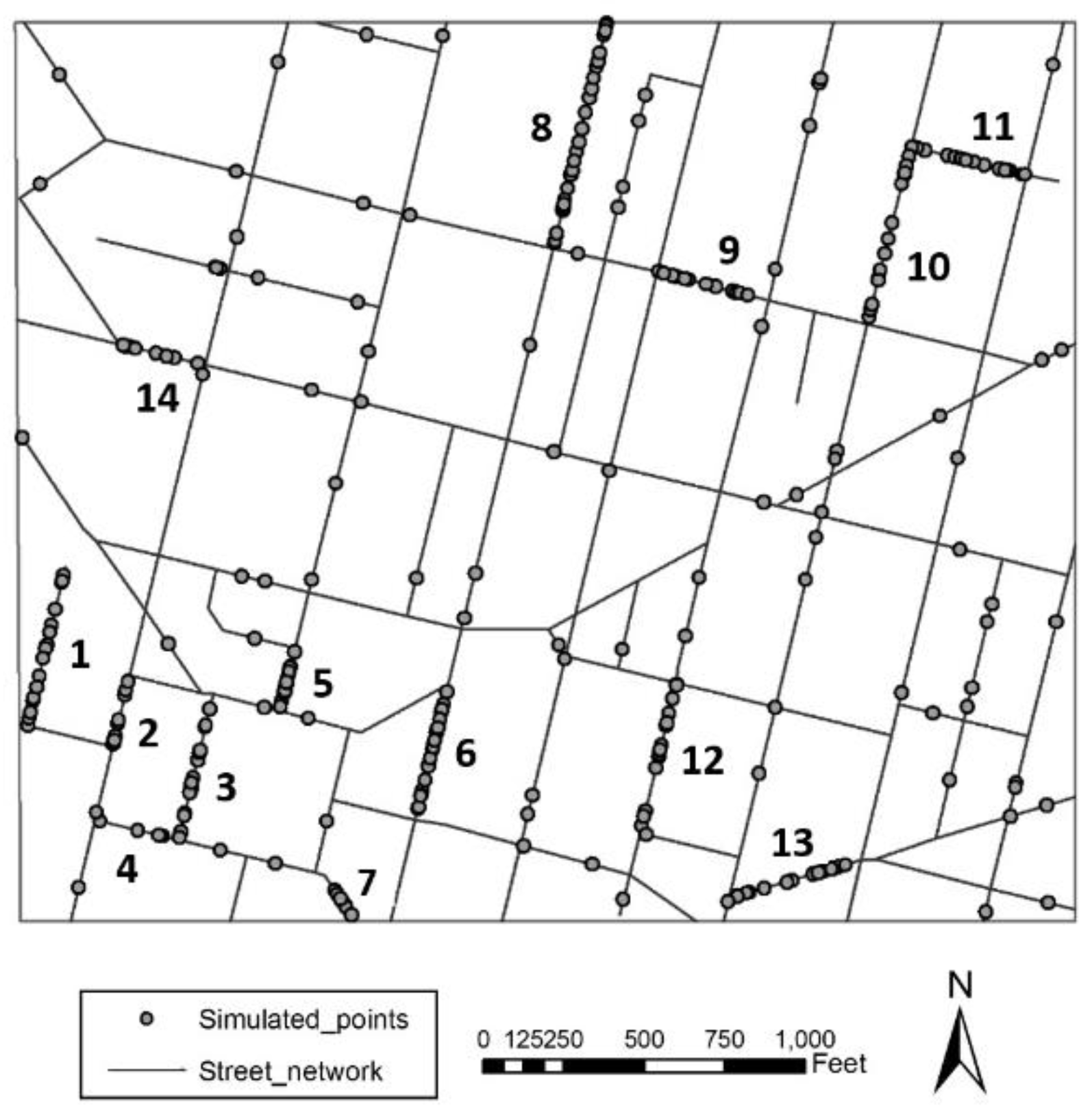
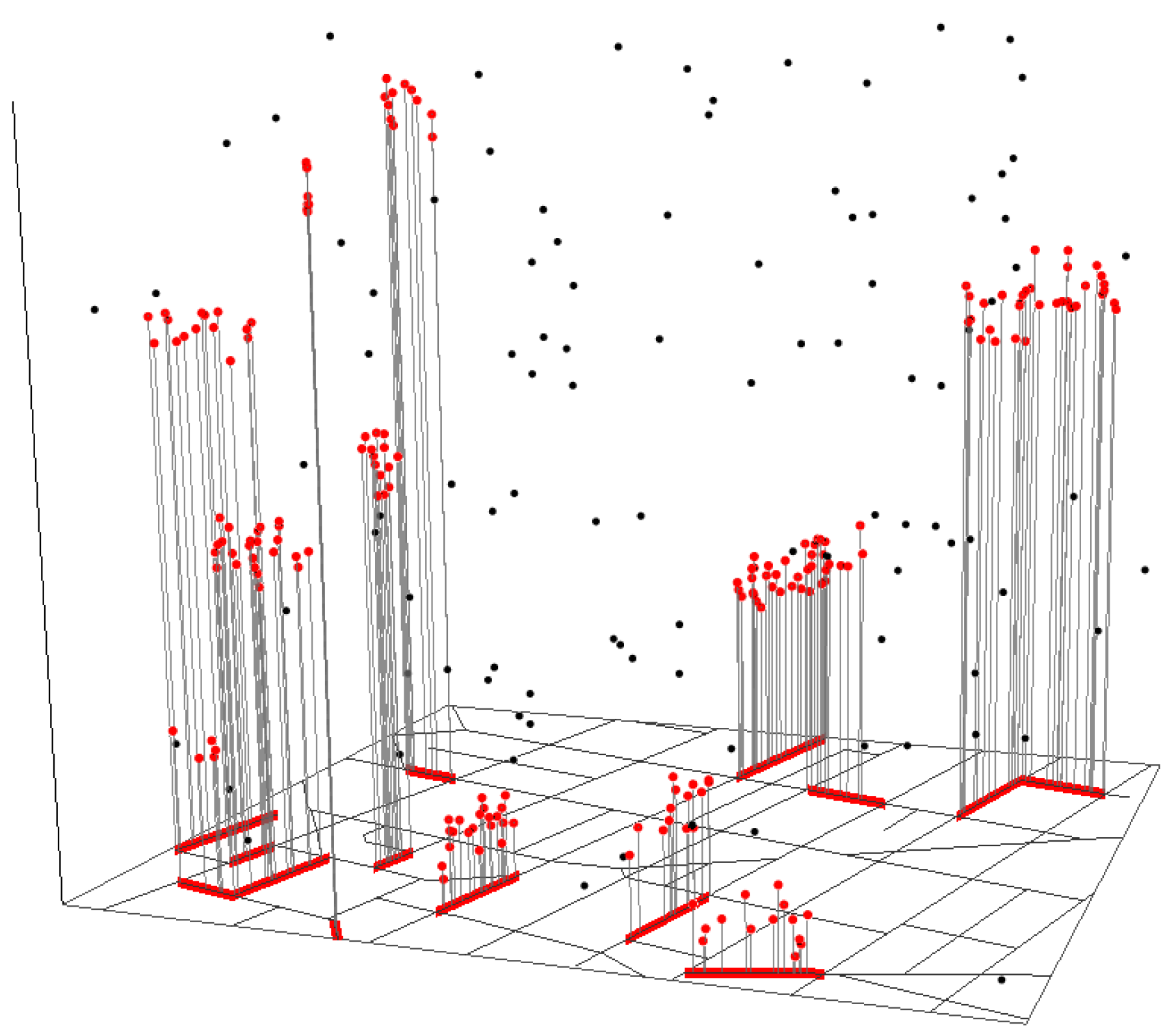

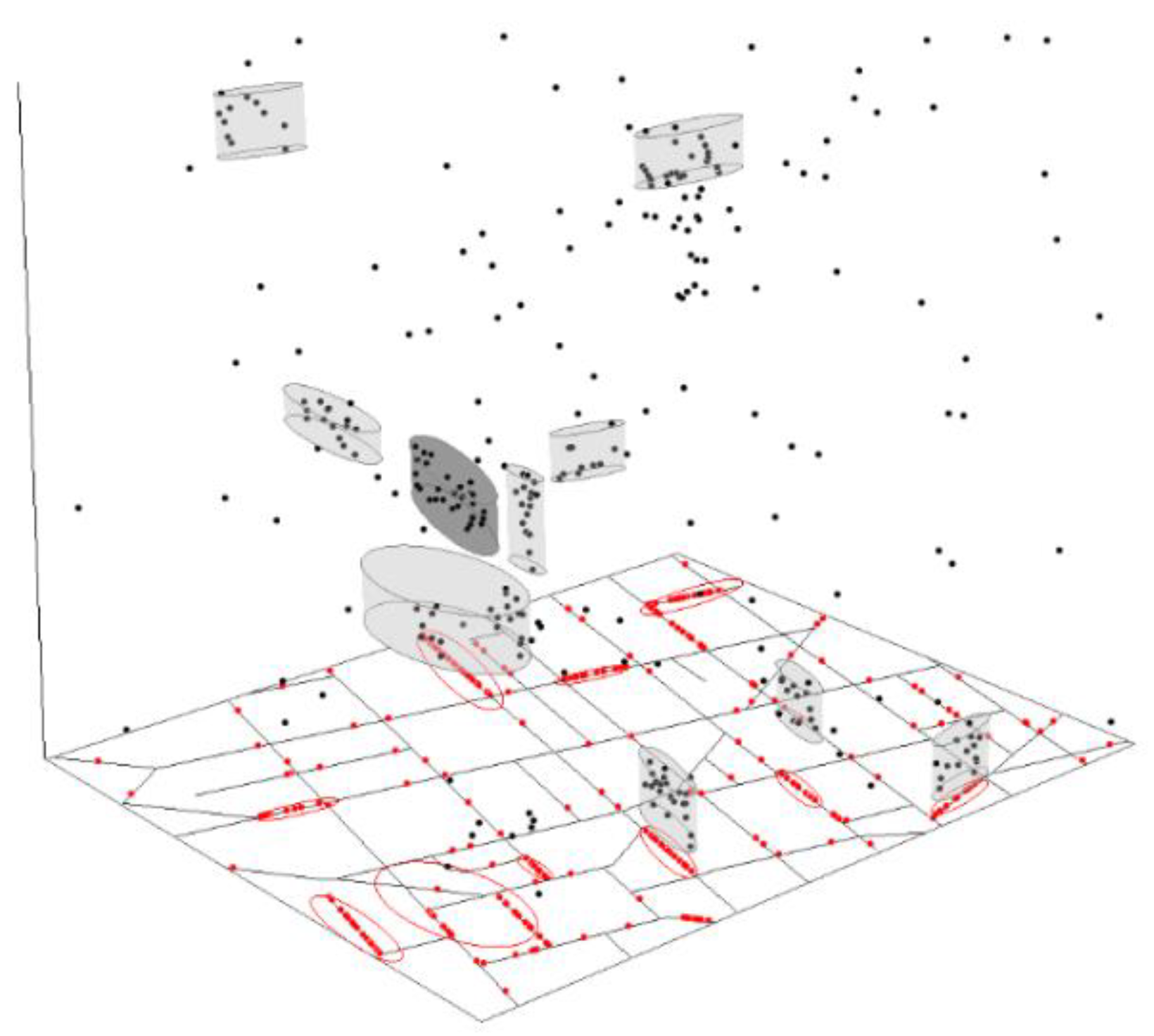
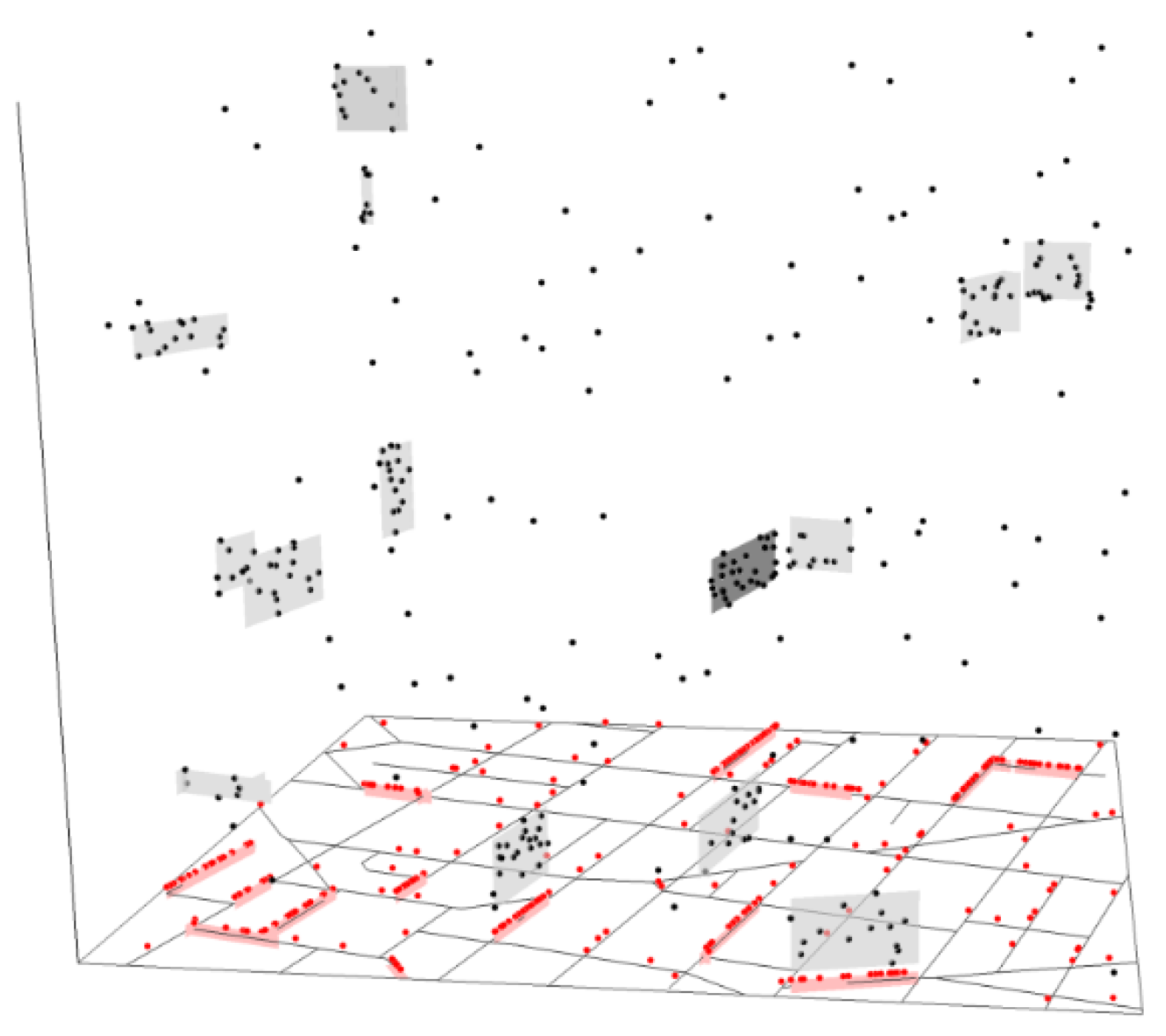
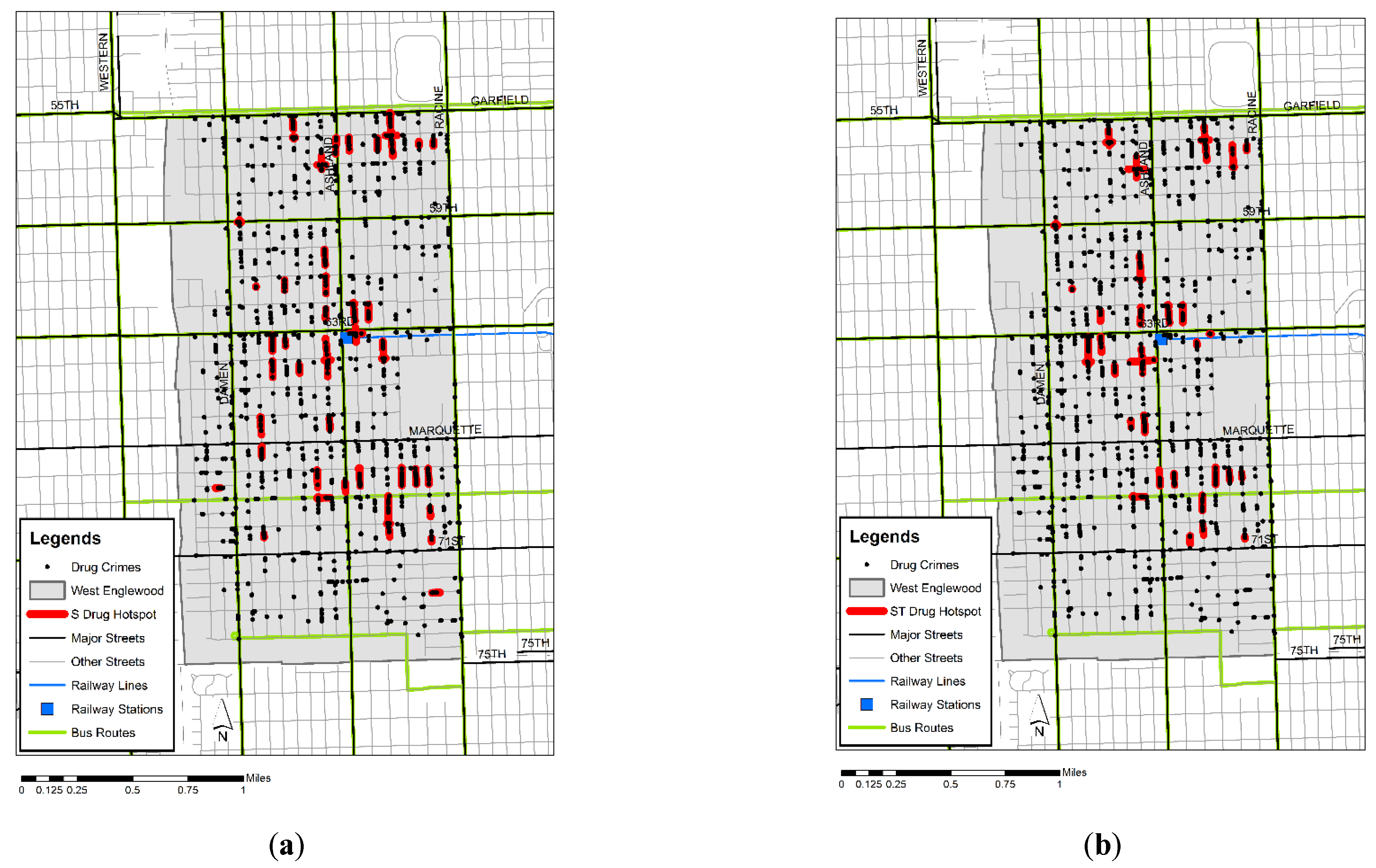
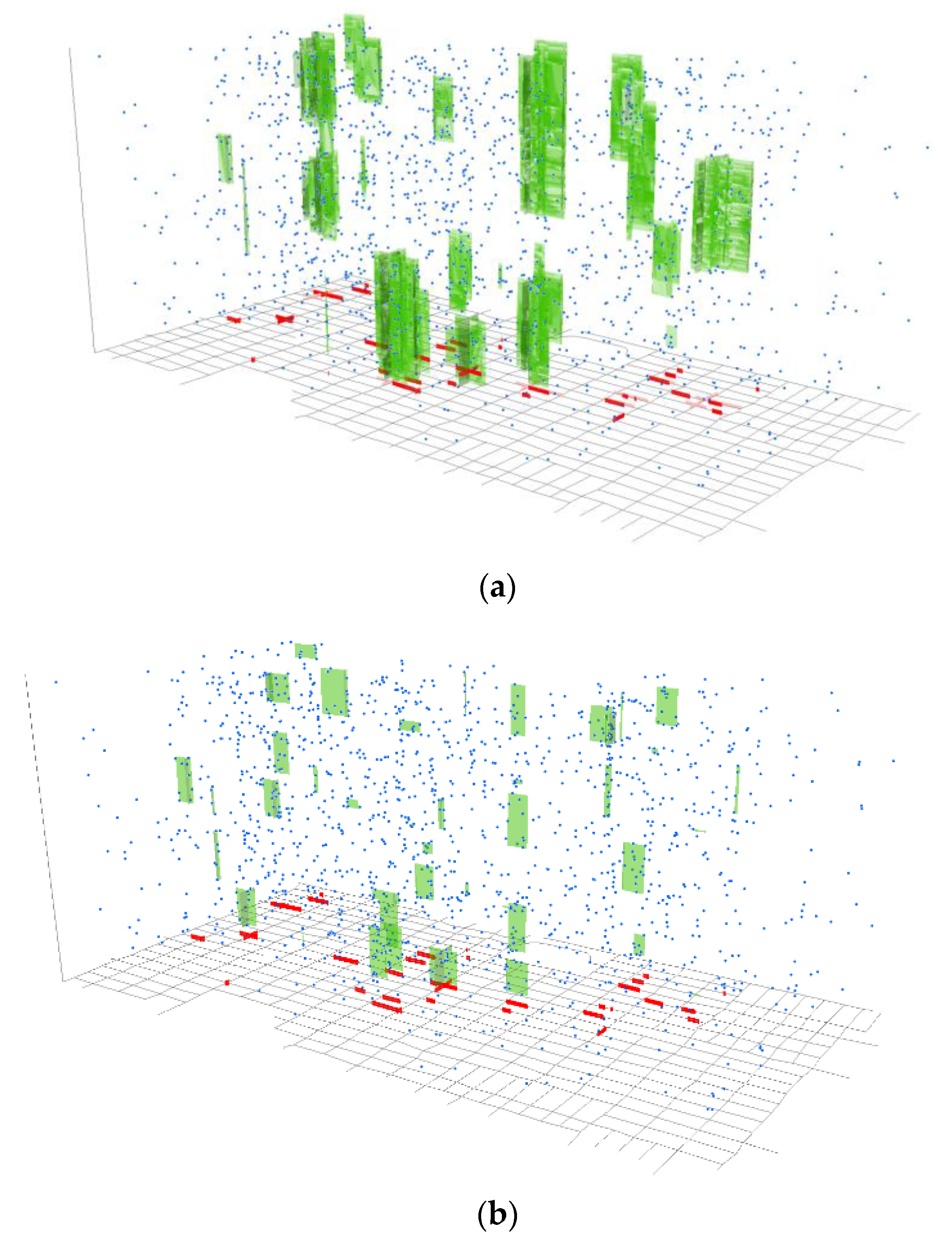
| Hotspot ID | Start Date | End Date | Number of Events |
|---|---|---|---|
| 1 | 221 | 251 | 15 |
| 2 | 135 | 165 | 8 |
| 3 | 130 | 160 | 16 |
| 4 | 59 | 89 | 5 |
| 5 | 167 | 197 | 14 |
| 6 | 12 | 42 | 21 |
| 7 | 288 | 318 | 8 |
| 8 | 84 | 114 | 30 |
| 9 | 109 | 139 | 10 |
| 10 | 227 | 257 | 15 |
| 11 | 242 | 272 | 19 |
| 12 | 34 | 64 | 14 |
| 13 | 7 | 37 | 14 |
| 14 | 327 | 357 | 11 |
| PPV | Sensitivity | |
|---|---|---|
| Circular PLScan | 0.23 | 0.62 |
| Elliptic PLScan | 0.74 | 0.65 |
| NetScan | 0.99 | 0.88 |
Publisher’s Note: MDPI stays neutral with regard to jurisdictional claims in published maps and institutional affiliations. |
© 2022 by the authors. Licensee MDPI, Basel, Switzerland. This article is an open access article distributed under the terms and conditions of the Creative Commons Attribution (CC BY) license (https://creativecommons.org/licenses/by/4.0/).
Share and Cite
Shiode, S.; Shiode, N. Network-Based Space-Time Scan Statistics for Detecting Micro-Scale Hotspots. Sustainability 2022, 14, 16902. https://doi.org/10.3390/su142416902
Shiode S, Shiode N. Network-Based Space-Time Scan Statistics for Detecting Micro-Scale Hotspots. Sustainability. 2022; 14(24):16902. https://doi.org/10.3390/su142416902
Chicago/Turabian StyleShiode, Shino, and Narushige Shiode. 2022. "Network-Based Space-Time Scan Statistics for Detecting Micro-Scale Hotspots" Sustainability 14, no. 24: 16902. https://doi.org/10.3390/su142416902





